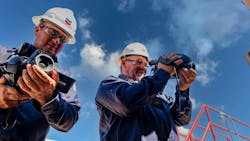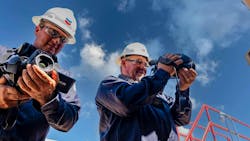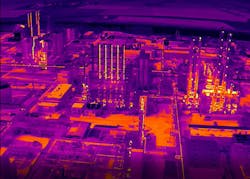The High-Tech Battle Against Fugitive Emissions Takes Shape
Fugitive emissions, those leaks and irregular releases of gases and vapors that have plagued operating companies forever, are up against of raft of new technologies that are helping to both identify and rectify them. Chevron, Wacker and Shell are among the most innovative adopters.
In the case of Chevron, its operations range from offshore platforms and refineries to gas-gathering systems and unconventionals in the Permian basin.
Its detection technologies are similarly diverse: satellites, planes, drones and optical gas imagers to name but a few.
“In this space there isn’t a one size fits all solution,” says Vanessa Ryan, Chevron’s methane reduction manager.
So, while the company has a “find and fix” program for emissions, the technologies that help achieve this vary and are constantly being added.
“Ten years ago, we probably had two options, a sniffer and an optical gas imager (OGI),” Ryan explains. “Today, we have more than 100 technology companies trying to sell us equipment, and many are already commercial enterprises. In my career nothing else has seen this rate of change.”
Chevron’s enterprise approach means that technology is applied in the most sensible way for a particular asset.
As part of this strategy, the company works closely with the Methane Emissions Technology Evaluation Center at Colorado State University. A set of controlled release points there allow Chevron and other operating companies and vendors to test sensor and algorithm combinations against known releases of emissions. “We work with vendors to get the best possible package,” she says.
The company also is carrying out many in-house emissions investigation projects.
One example is Project Canary, a small pilot taking place in Chevron’s Rockies and Permian business units.
“It’s a certified gas pilot that includes fixed sensors and a third-party evaluation of our practices and systems,” explains Ryan.
The sensor portfolio being used there includes high-fidelity spectroscopy-based methane detection and emissions quantification and laser-based gas analyzers.
While Project Canary involves multiple sensors around one source, it is expensive in terms of hardware. Project Astra, on the other hand, is looking at the possibility of having, for example, one sensor per site in the Permian basin. The idea is that sensors on different operators’ sites would work together to develop a regional sensing model that is less sensor dense and therefore more cost efficient.
“It’s proceeding very well and, in fact, the University of Texas has just been awarded a $4 million grant to expand the pilot both geographically and further down the value chain. Right now, it’s just production sites, but the new grant expands into gathering and boosting and gas treatment,” Ryan notes.
Optimizing Emission Detection With Autonomous Controls
One positive outcome from Chevron’s emissions detection strategy is the development of its real-time autonomous optimizer (RAO) for tank emissions. Such emissions are a known challenge in unconventional development because you must manage pressure and temperatures from multiple wells going into the same facility and what leaves the facility needs to be managed and sent to pipeline.
“We have installed pressure and temperature monitors across our system for many, many years, but more recently our thinking about this changed,” Ryan says.
An RAO pilot in 2020 looked at the pressure and temperature gauges in tanks and tried to predict when the company might have an overpressure situation that could result in upset emissions and then prevent it by autonomously throttling back the wells that are feeding that facility to take pressure off that tank.
“So instead of saying ‘the thief hatch has just popped again; I’m going to go close it,’ we’re trying to prevent it from popping in the first place by using a very process engineering lens to think about how we prevent this emission source,” she says. “We use our leak-detection data to look at sources, but the solution is very much a process engineering solution.”
Ryan's methane-reduction team is responsible for ensuring that the best practices identified through their activities are disseminated and implemented across Chevron as quickly as possible.
“We’ve brought together some really bright minds with different functions, including facility engineers, gas plant operators, a compliance expert and two people who really understand how to model atmospheric emissions,” she explains.
The overarching goal for Ryan is to not only “find and fix” emissions issues, but also to leverage the extensive emissions data collected through Chevron's various tools and techniques. This data should then inform and improve the company's approach to designing and operating its facilities.
“Nobody wants to wake up and go find and fix the same emissions every day. We want to learn and continue to improve,” she says.
Wacker Turns to Drones
Between 2012 and 2022, German multinational chemical company Wacker Chemie reduced energy demand of units at its Nünchritz, Germany, site by 50%. Since then, it has worked to identify other areas for improvement and implement measures to help achieve its target of a further 15% reduction by 2030.
One tool to help with this has been a drone-deployment program, which started in 2022 with an initial focus on heating pipe networks on the site. The ongoing project currently involves buildings, with plans to use the drones at production facilities in the future, according to the company.
The company is looking to check the quality of insulation in heating networks and identify any potential heat losses and fugitive emissions. The company is looking to evaluate how insulation performs in heating systems and detect any instances of heat dissipation or unintended emissions that may arise.
Equipped with a thermal imaging camera, the drone creates an image analysis of the entire 321-acre site. Cold nights are ideal for this purpose to emphasize temperature differences between piping systems and the surrounding ground.
The sensors on the camera detect thermal radiation in the IR spectrum and convert it to colored images. The color scale corresponds to a temperature scale and suitable measures for reducineg heat loss are then prioritized and implemented for the calculation data collected.
Wacker expects to save several hundred kilowatts in energy and further reduce fugitive emissions at Nünchritz.
The findings from this project have led to several modifications, according to a company spokesperson. Notably, the company will accelerate replacement of decades-old insulation in certain areas with more modern insulation technology. The company is including insulation defects they have identified through the program into the repair schedule for correction. Regular inspections with drones and thermal imaging now are carried out as part of the standard preventive maintenance plan. .
While the company spokesperson would not identify the drone or IR spectrum equipment vendors, she indicated that they are both industry standard.
Fugitive Emissions: The Cost of Noncompliance
Lapses in fugitive emissions monitoring can be costly, as Evonik found in April 2023 when the U.S. Environmental Protection Agency (EPA) fined the company $75,000 for violations at its cleaning products manufacturing facility in Reserve, Louisiana.
As part of that settlement, the company also agreed to perform a supplemental environmental project (SEP) to further reduce facility-wide emissions.
This, in turn, will involve a minimum spend of $335,000 to design, install and operate a vapor recovery system to capture volatile organic compounds (VOCs), which are currently permitted for release to the atmosphere while trucks load and unload.
The captured VOCs will be routed to a new thermal oxidizer/flare system. According to the EPA, the SEP will be fully operational no later than Dec. 31, 2026, and is expected to reduce VOC emissions by an additional 2.6 tons/yr.
The sanctions came about as part of the Pollution Accountability Team, an air-monitoring project developed by EPA enforcement teams based on concerns of area residents.
The initiative combined advanced air-pollution monitoring and real-time physical inspections. EPA’s ASPECT airplane collected emissions data from facilities, while the agency’s Geospatial Monitoring of Air Pollution, or GMAP, vehicle monitored pollution levels at facility fencelines and adjacent neighborhoods.
If the monitoring results indicated heightened emission levels, teams of inspectors from the Environmental Protection Agency (EPA) and the Louisiana Department of Environmental Quality were prepared to conduct unannounced, on-site inspections at specific facilities for further investigation.
Evonik has already replaced its scrubber with a more efficient flare, which will destroy 98% of emissions routed to it, according to the EPA. It now has to install the thermal oxidizer and be required to operate it with a minimum destruction efficiency of 99.9% as demonstrated by a required initial performance test.
The company also is implementing an enhanced leak-detection and repair program, which will help minimize fugitive emissions of ethylene oxide and other VOCs.
Shell’s Mixed Fleet of Technologies
Meanwhile, Shell has teamed up with Energy Robotics to provide automated inspection technologies for use at its Energy and Chemicals Park Rheinland near Cologne, Germany.
Energy Robotics is supplying two robots and a drone, plus its bespoke software platform, which will act as a single unified interface for managing them.
Due to the heterogeneous environments of the different plants at the Park, Shell has opted for a mixed fleet, including the walking robot Spot from Boston Dynamics and ExR-2 from ExRobotics.
Spot can navigate reliably over stairs and through narrow areas in non-hazardous environments. ExR-2 is a rugged, tracked robot designed to perform inspection tasks in areas with explosion hazards.
Shell will use the beyond visual line of sight drone to inspect the roofs of tank farms and inspection points that are difficult to access.
Following approval by the German Federal Aviation Authority, Shell can carry out regular drone operations with it.
Using Energy Robotics’ software, the drone automatically ascends from its docking station and executes pre-defined inspection missions. These can include checking the integrity of tank roof seals, identifying the presence of rainwater and investigating the condition of grounding cables. The software uses the high-resolution and thermal images captured to identify any such issues.
According to Energy Robotics, its technology does away with tedious manual inspections that previously demanded operators climb 19, 82-foot-high tanks to check their floating roofs. This also minimizes the potential for workplace accidents.
The drone and both robots are equipped with visual and thermal cameras and other sensors, which together can read pressure and temperature gauges, while also analyzing valve positions or objects, such as fire extinguishers, and record thermal images of insulation and machines to detect thermal anomalies. They also can detect fugitive emissions in the parts per million range.
The different specifications of the individual models give the company the flexibility needed to inspect a large number of inspection points automatically, a Shell spokesperson said.
However, it is unclear if any of these activities will be affected following Shell Deutschland’s 26 January announcement of its plans to convert the hydrocracker at Wesseling on the Energy and Chemicals Park Rheinland from a crude-oil processor into a production unit for specialty oils. Crude-oil processing is slated to end there by 2025 but will continue at the neighboring Godorf site, which is also located within the Park.
The high degree of electrification of the base oil plant, as well as the ceasing of crude oil processing into fuels at the Wesseling site, is expected to reduce Shell’s scope 1 and 2 carbon emissions by around 620,000 metric tons a year.
About the Author
Seán Ottewell
Editor-at-Large
Seán Crevan Ottewell is Chemical Processing's Editor-at-Large. Seán earned his bachelor's of science degree in biochemistry at the University of Warwick and his master's in radiation biochemistry at the University of London. He served as Science Officer with the UK Department of Environment’s Chernobyl Monitoring Unit’s Food Science Radiation Unit, London. His editorial background includes assistant editor, news editor and then editor of The Chemical Engineer, the Institution of Chemical Engineers’ twice monthly technical journal. Prior to joining Chemical Processing in 2012 he was editor of European Chemical Engineer, European Process Engineer, International Power Engineer, and European Laboratory Scientist, with Setform Limited, London.
He is based in East Mayo, Republic of Ireland, where he and his wife Suzi (a maths, biology and chemistry teacher) host guests from all over the world at their holiday cottage in East Mayo.




